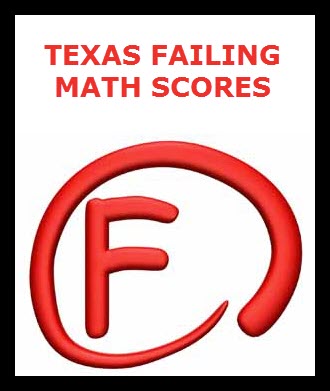[10.7.14 — I wonder when reporters such as Terrence Stutz are going to try to investigate exactly why Texas’ public school students have lost ground on the SAT. Could it be (duh?) that leading up to this last round of SAT testing, at least 893 ISD’s, charters, and private schools in Texas have been using the Texas version of Common Core called “CSCOPE”?
CSCOPE was sold to Texas educators as being the answer to all problems! It was started in 2006; and in 2013 alone, the Education Service Centers collected over $15,000,000 ANNUAL fees from taxpayers for CSCOPE license fees.
With that huge amount of funding and the large numbers of schools using CSCOPE, Texas should have seen dramatic academic results on the SAT if CSCOPE (now referred to as the TEKS Resource System) were really working.
Obviously, CSCOPE (a.k.a., Common Core Standards) is not raising students’ SAT scores but instead is causing them to drop.
Texas has good Type #1 curriculum standards (TEKS). That is not the problem. The problem is that CSCOPE and Common Core are Type #2; and the subjective, constructivist philosophy of education is causing chaos in our schools and decreasing students’ academic results.
Taxpayers and parents should demand that their tax dollars not go to pay for CSCOPE, TEKS Resource System, Common Core, or any other Type #2 curriculum (progressive). Not only is that money down the drain, but students’ academic achievement is suffering because of the wrong-headed Type #2 philosophy advocated by those products. – Donna Garner]
10.7.14 – Dallas Morning News
http://www.dallasnews.com/news/local-news/20141007-texas-sat-math-scores-hit-a-22-year-low.ece
Texas’ SAT math scores hit a 22-year low
Excerpts from this article:
|
|
|
|
|
|
|
|
|
|
By TERRENCE STUTZ
Austin Bureau
Published: 07 October 2014 05:37 AM
Updated: 07 October 2014 05:39 AM
AUSTIN — Texas high school students slipped to their lowest SAT math scores in more than two decades this year, while reading scores on the college entrance exam were the second lowest during that period.
Results being released Tuesday by the College Board, which administers the exam, showed that the average score on the math section of the SAT dropped four points from last year to 495. That was the lowest figure since 1992, when Texas students recorded an average score of 493. A perfect score is 800.
In reading, the Class of 2014 in Texas scored an average 476. That was down slightly from last year but still two points better than their worst showing in the past two decades. That occurred in 2012.
In writing, Texas students registered an average 461 for the third year in a row.
Students across the U.S. saw their scores in math drop slightly. But the long-standing achievement gap between Texas and the nation grew significantly this year. In reading, the average score nationwide increased slightly and remained well above the average in Texas.
State education officials have attributed the declining SAT scores in Texas to an increase in the number of minority students taking the exam. Minorities generally perform worse than white students on standardized achievement tests like the SAT and ACT, the nation’s two leading college entrance exams.
However, California students outperformed Texans by big margins this year — 15 points in math and 22 points in reading. Demographics of the student populations in the two states are similar: California is 52.7 percent Hispanic and 25.5 percent white, while Texas is 51.3 percent Hispanic and 30 percent white.
In addition, more than 60 percent of seniors in both states took the SAT. School districts have in recent years encouraged students to take either the SAT or ACT to get them thinking about what to do after high school.
The drop in SAT math scores is likely to rekindle debate over the state’s recent decision to no longer require that all high school students take Algebra II. Over the objections of business and minority-rights groups, the Legislature and State Board of Education dropped Algebra II as a requirement except for students in advanced graduation plans.
Among those groups were the Texas Association of Business and Mexican American Legal Defense and Educational Fund.
Bill Hammond, a former Texas House member who leads the influential business group, said at the time that the state’s retreat on Algebra II and other more challenging courses “dooms generations of students to a mediocre education and low-wage jobs.” Hammond also pointed out that research shows students who skip the course get lower scores in math on the SAT and ACT and are less prepared for college.
Officials for the College Board said an analysis of this year’s results shows that too many students missed opportunities that would have helped them do better on the exam and be better prepared for college-level classes.
Foremost is a more challenging lineup of courses that includes four or more years of English, and three or more years of math, science and social studies.
“The latest SAT results reaffirm that we must address the issue of preparedness much earlier and in a more focused way,” said Cyndie Schmeiser, chief of assessment for the College Board. “Students in the Class of 2014 missed opportunities that could have helped more of them make successful transitions to college and career.”
The College Board reported that just over a third of the 179,036 Texas students who took the SAT met its college and career readiness benchmark, which requires a score of 1,550 out of a possible total of 2,400. That was well under the national average of 42.6 percent who hit the benchmark.
Most minority students, as in the past, fell far short of the benchmark. Only 19 percent of Hispanic and 14 percent of black students in Texas met the college readiness standard. Both percentages trailed the national averages for those groups.
…In Texas, about 61 percent of high school seniors who took the SAT were minorities, compared with a national average of 47.5 percent.
Follow Terrence Stutz on Twitter at @tstutz.

